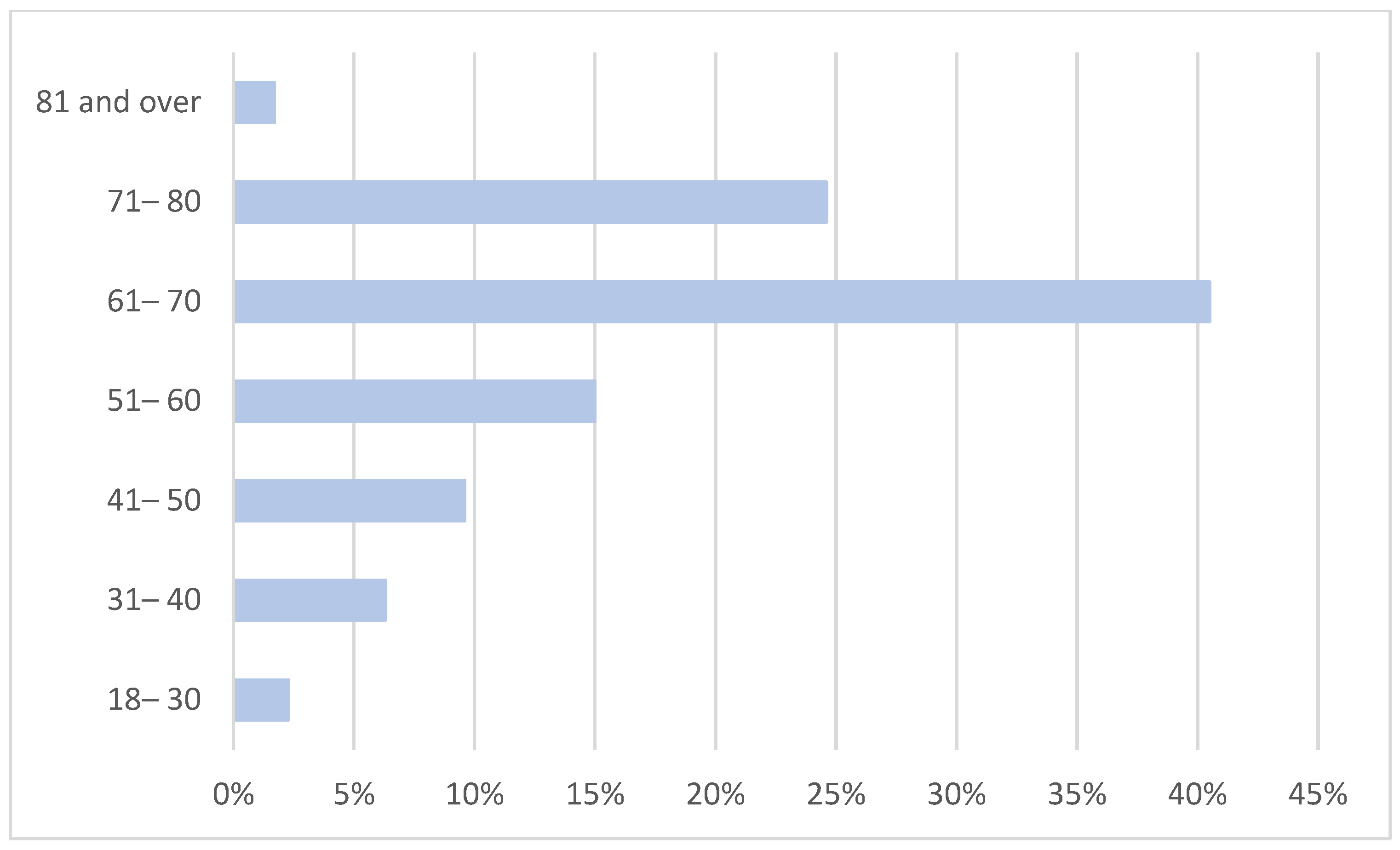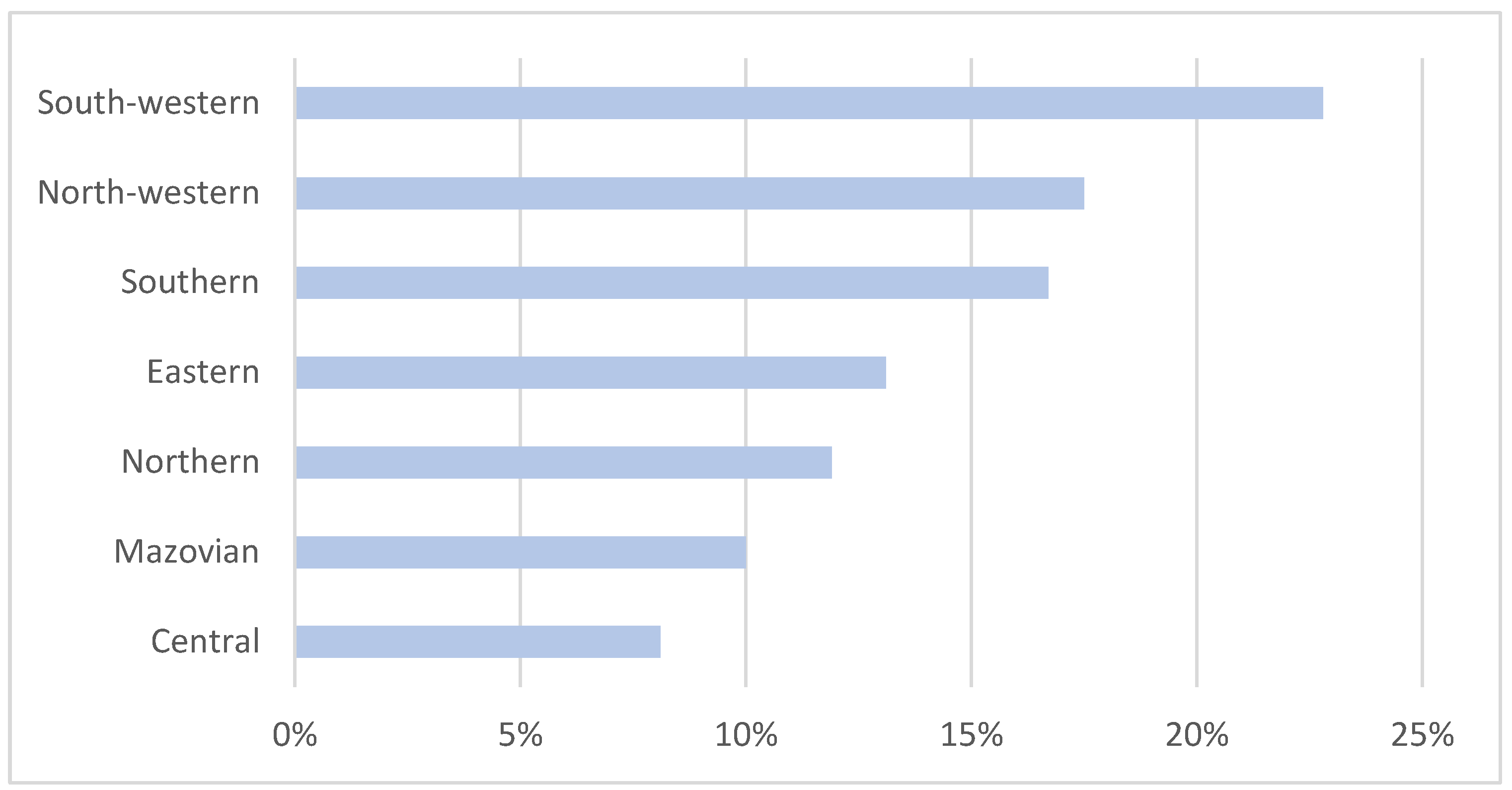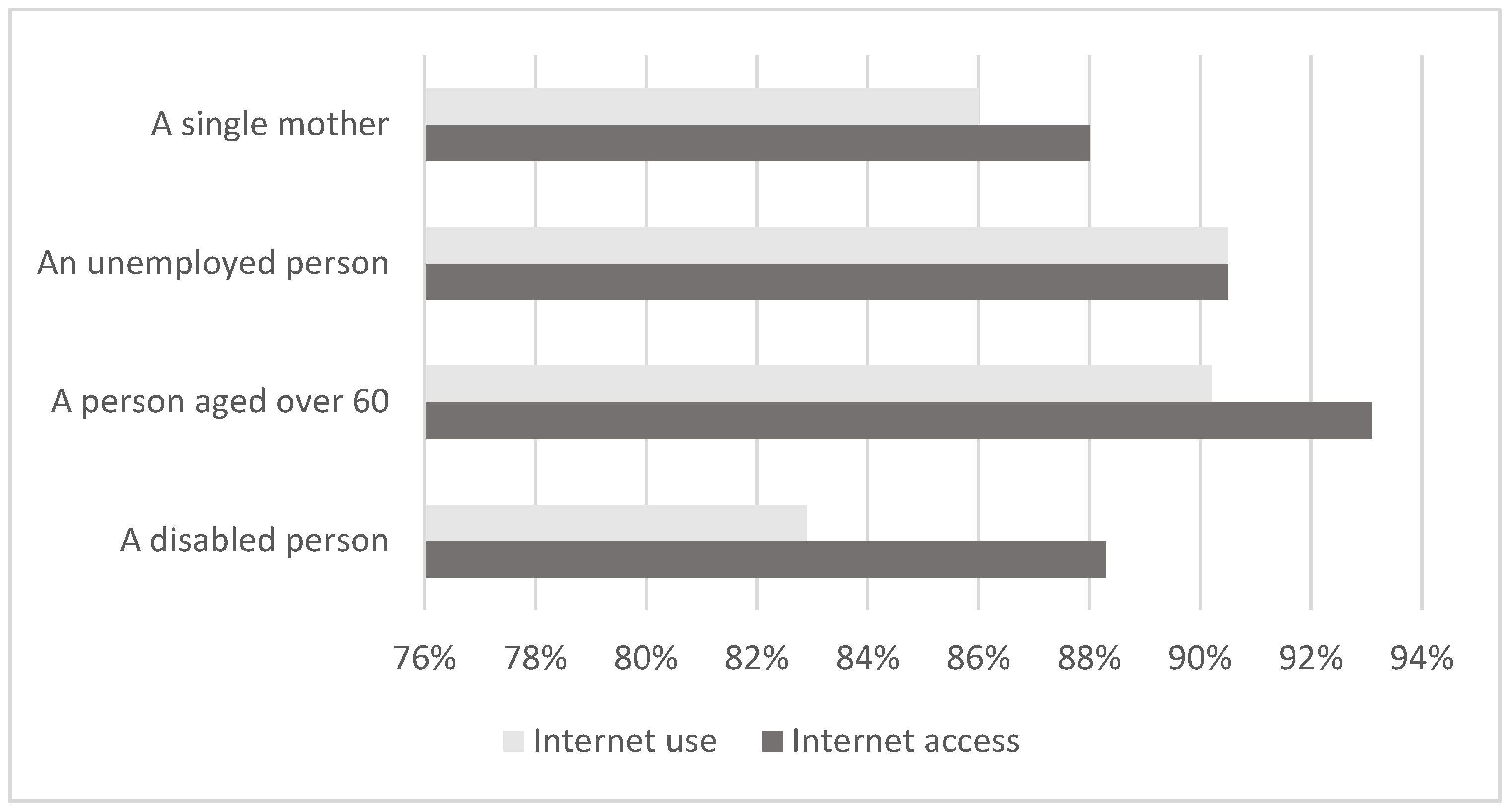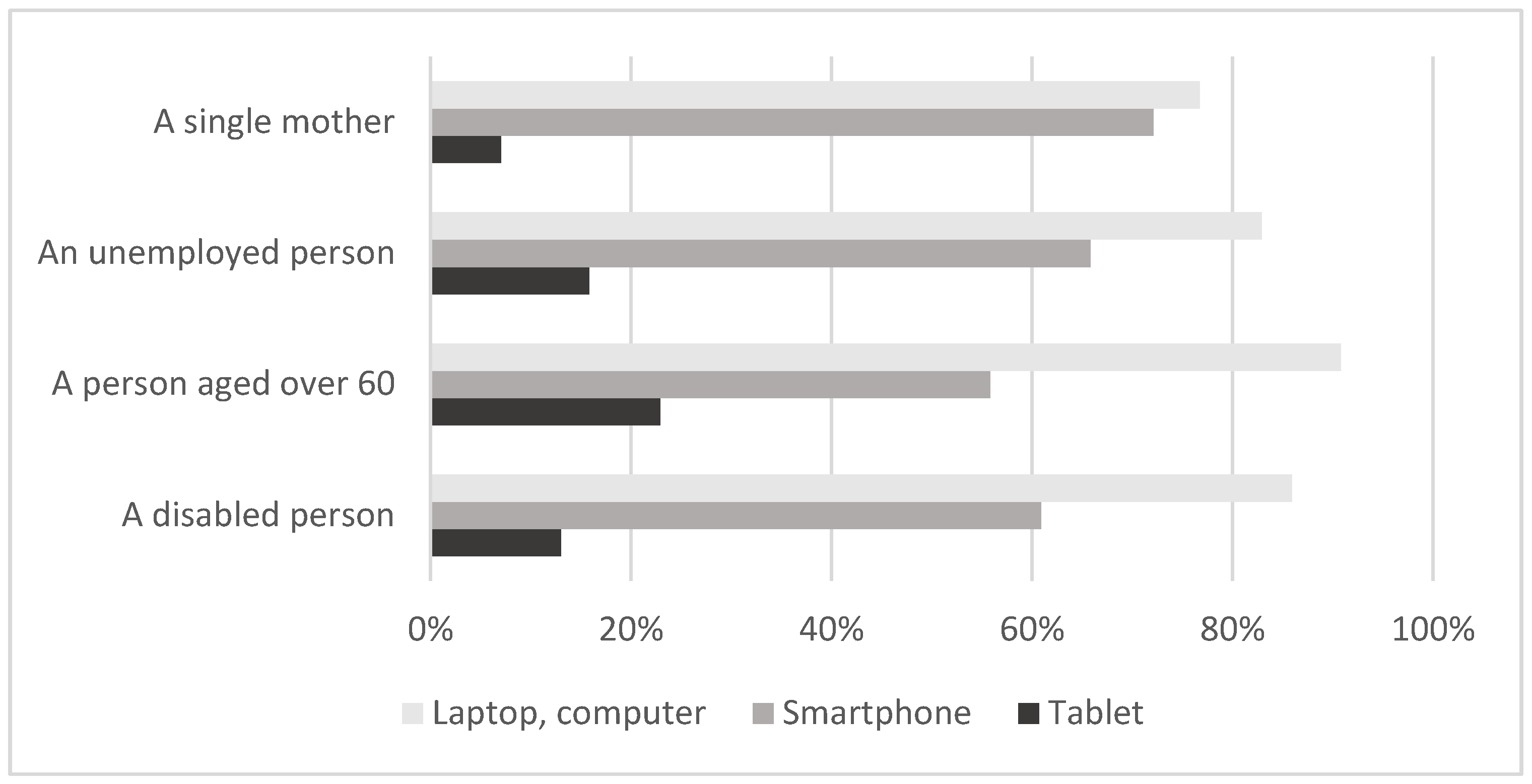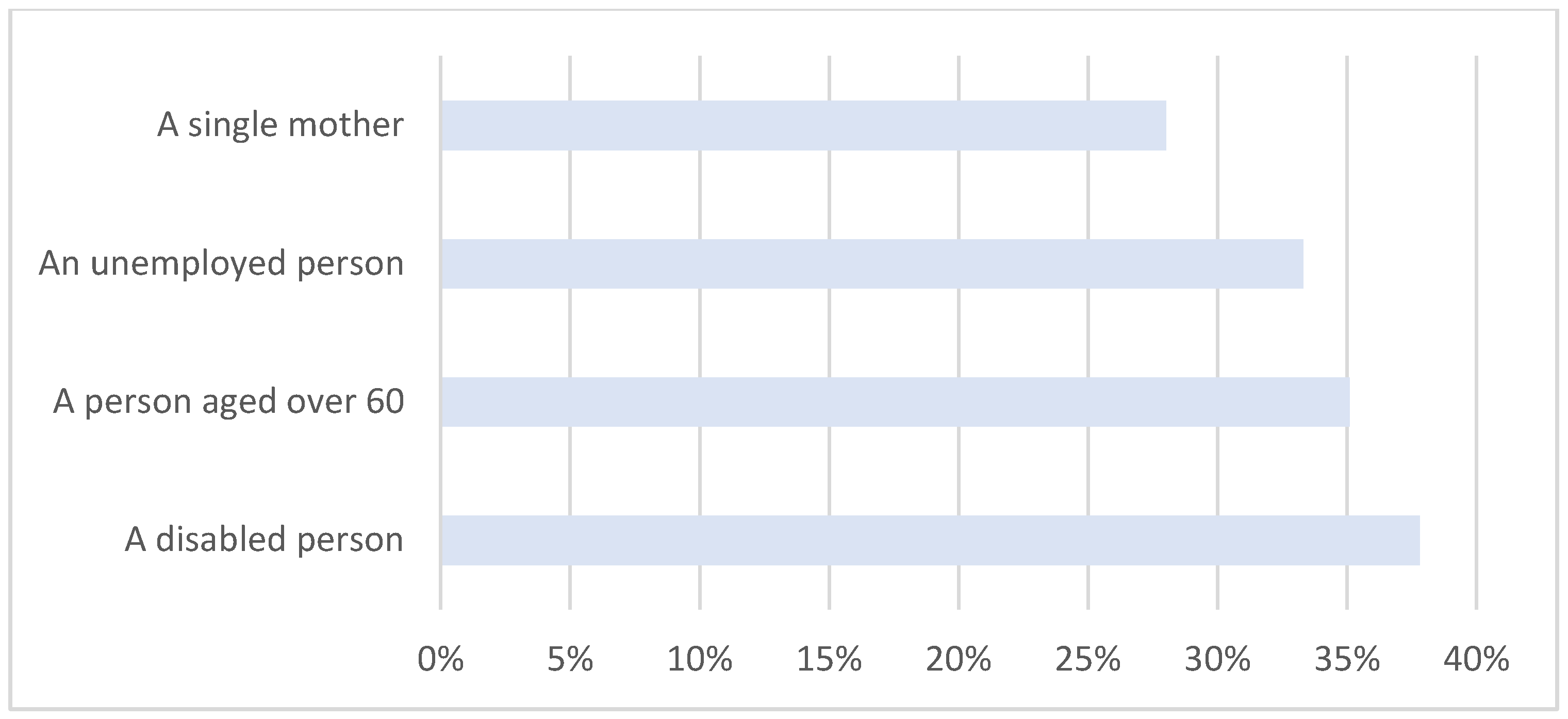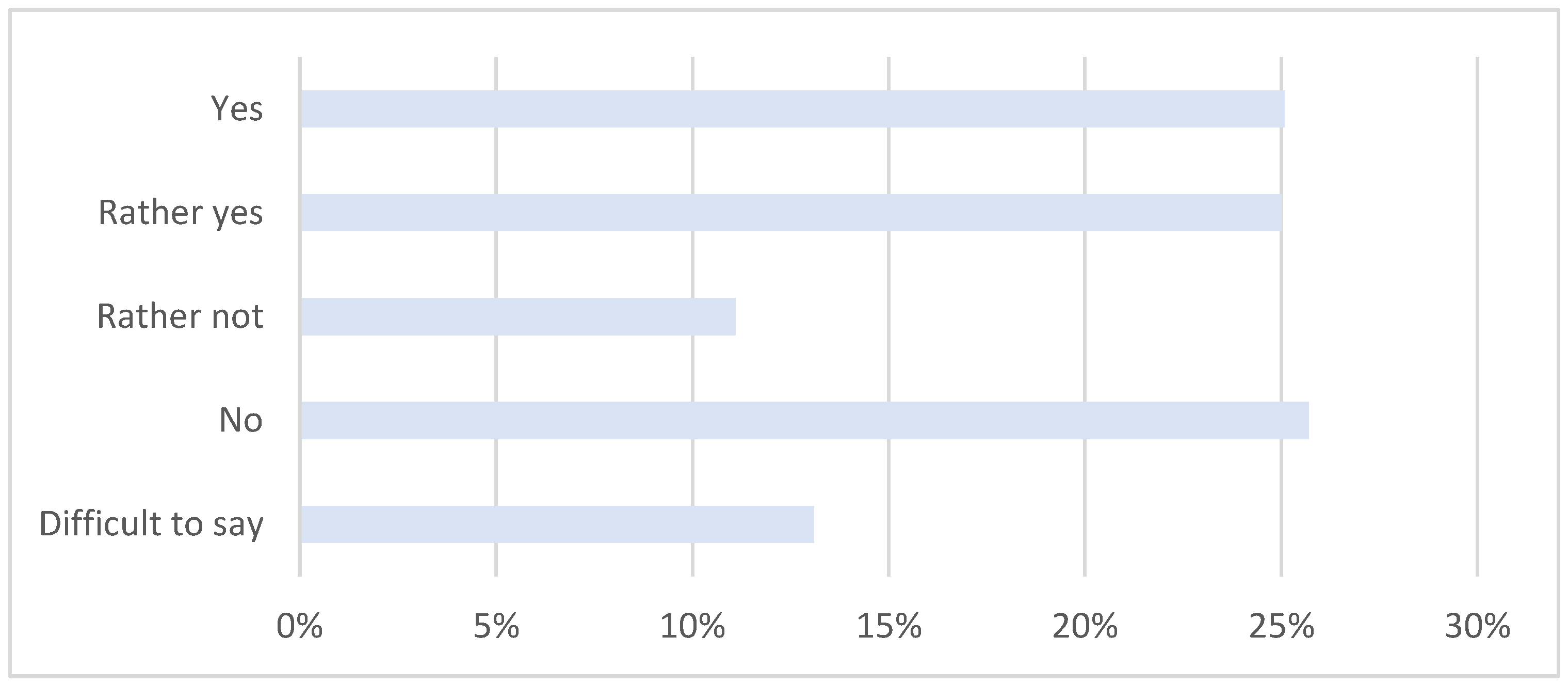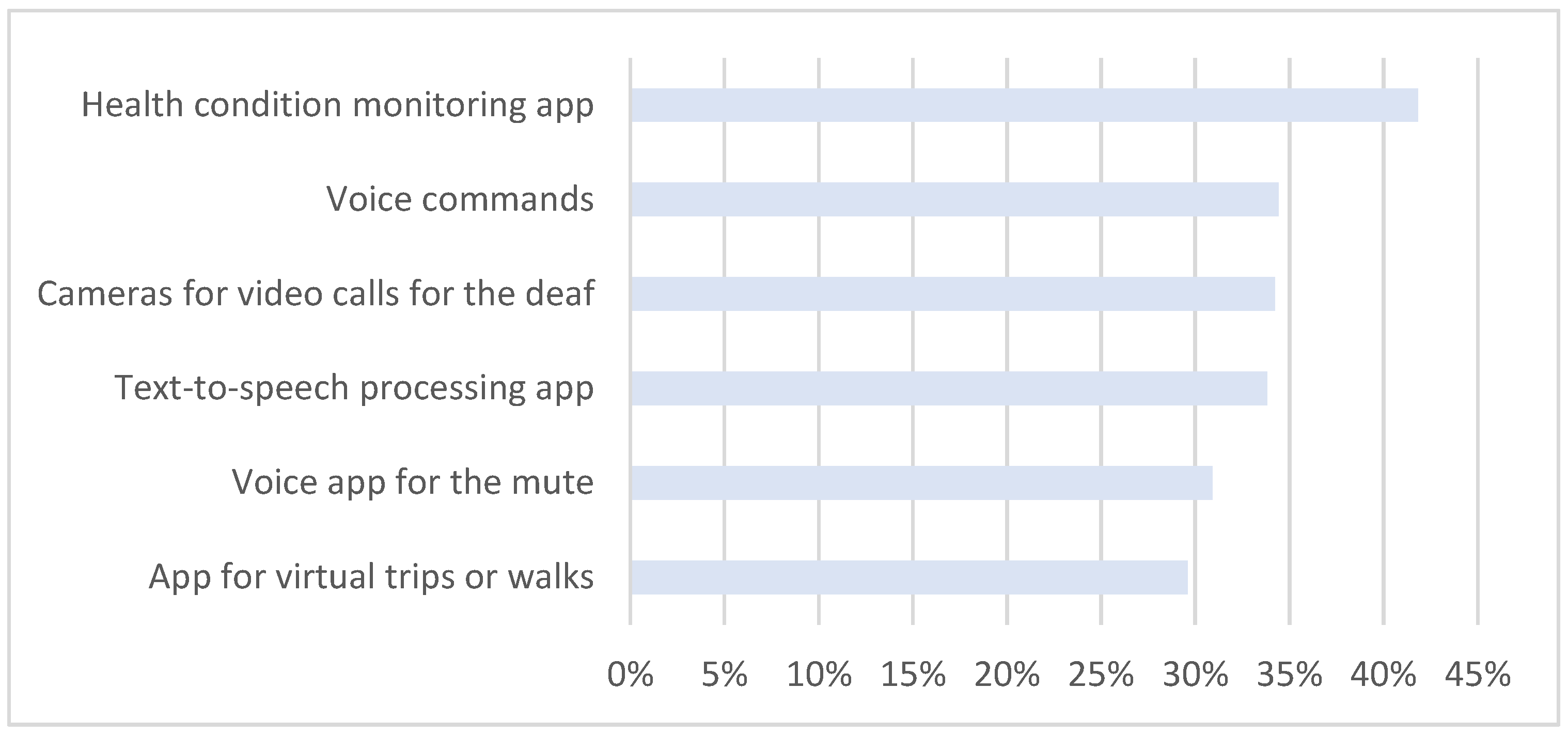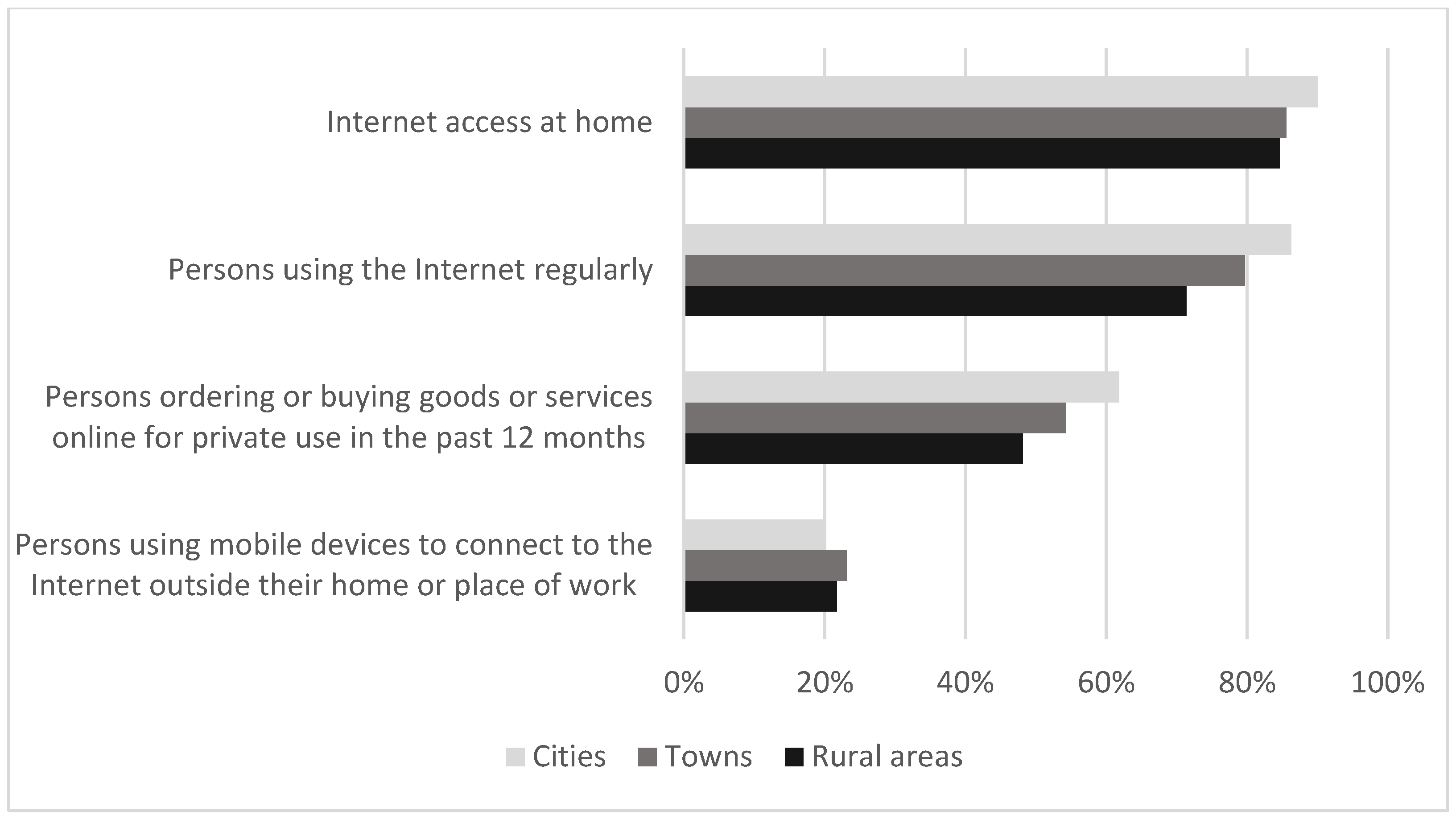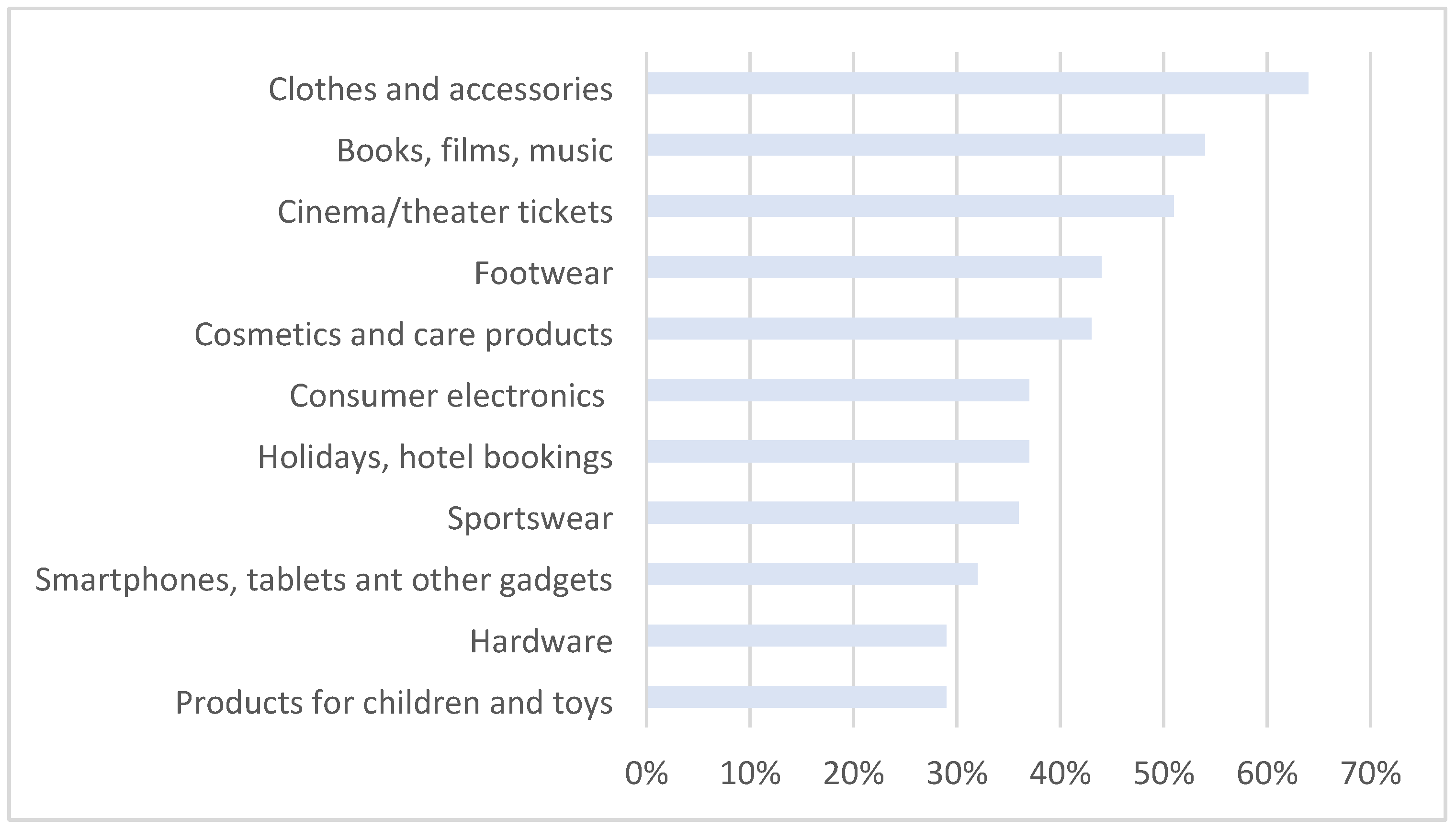2.1. The Internet of Things: Approach and Definitions
The origin of the Internet of Things (IoT) is associated with a British expert in digital innovations, Kevin Ashton, who used the term, “Internet of Things”, for the first time, in 1999, at a presentation for Procter & Gamble. In that approach, the IoT is a “network of devices that exchange data with other devices instead of with their users” [
5] (p. 2). As Kevin Ashton stated, the difference between the devices used to date and those from the 21st century lies in the fact that data required by the previously used devices had to be fed by human beings, whereas now the devices are capable of collecting and sending data on their own. Hence, the “essence of the Internet of Things” is the fact that data are collected, processed, and sent by devices without the necessity of involving humans in the process [
5]. Such an approach was a starting point for the development of the IoT concept.
However, in practice, it was not developed until 2008–2009, when the number of devices connected to the Internet exceeded the global population. That moment marked the beginning of the concept of the IoT [
6].
The term Internet of Things is not easily defined, mostly related to failure, by various environments, to accept what the IoT is in reality. It has been defined differently by researchers and scientists versus developers and corporate workers. However, based on its universal definition, it is assumed that it is an “an open and comprehensive network of intelligent objects that have the capacity to auto-organize, share information, data and resources, reacting and acting in face of situations and changes in the environment” [
7] (p. 165). According to another definition of the IoT, it “is the interconnected sphere of physical devices with the Internet and other networks through uniquely identifiable IP addresses, whereby data is gathered and communicated through embedded sensors, electronics and software” [
8].
Mocnej, J. et al. drew attention to the diversity of approaches to the IoT linked to developments in that field and the multidimensional nature of the related research [
9] (p. 2), providing another two definitions for the term. The first definition by ITU is: “The Internet of Things is a global infrastructure for the information society, enabling advanced services by interconnecting (physical and virtual) things based on existing and evolving interoperable information and communication technologies.” The other definition by ISOC is: “The term Internet of Things generally refers to scenarios where network connectivity and computing capability extends to objects, sensors and everyday items not normally considered computers, allowing these devices to generate, exchange and consume data with minimal human intervention. There is, however, no single, universal definition.” [
9] (p. 2).
Additionally, the European Commission referred to the concept of the IoT in its document entitled “Internet of Things. Position Paper on Standardization for IoT Technologies” dated 2015; they defined the IoT as “a dynamic global network infrastructure with self-configuring capabilities based on standard and interoperable communication protocols where physical and virtual “things” have identities, physical attributes, and virtual personalities and use intelligent interfaces, and are seamlessly integrated into the information network” [
10,
11] (p. 57).
Regardless of the approach and the definition’s level of detail, it should be concluded that the IoT has revolutionized the internet. Its primary task is to develop possibilities for connecting objects in any way, at any place and time, and using any network or service; therefore, those objects can communicate and provide information not just about them but also can access any other information. However, the essence of the IoT is merely something more than that as, apart from computers, that notion (the “thing”) refers to objects used on a daily basis which are controlled online. The above refers to technologically advanced devices such as vehicles, household appliances, radio and TV appliances, buildings, industrial systems, and many other objects connected to and communicating with each other, as well as such “things that we do not ordinarily think of as electronic at all—such as food, clothing, chair, animal, tree, water, etc.” [
12] (p. 6122).
It is a very broad approach to the implementation of the assumptions of the concept of the IoT and in such a broad context the Internet of Things is defined as “a concept and a paradigm that considers pervasive presence in the environment of a variety of things/objects that through wireless and wired connections and unique addressing schemes are able to interact with each other and cooperate with other things/objects to create new applications/services and reach common goals” [
12] (p. 6122). From that perspective the IoT allows virtually unlimited scope of research and implementation related to the establishment of a smart environment, also in the context of, for example, effective management of energy in households [
13].
Diversified approaches to the IoT are provided in the Report of the Working Group for the Internet of Things of the Ministry of Digital Affairs entitled “The IoT and the Polish economy” dated 2019. The report assumed that the Internet of Things could be defined depending on the area within which it was analyzed. Hence, the IoT was presented from three angles: technological, architectural, and business.
According to a technological definition, the Internet of Things is a “wired or wireless network used to connect devices which work autonomously (without any human interaction) to collect, share, and process data, or to interact with their surroundings on the basis of said data”. Such an approach assumes that distributed IT systems are built along with telecommunication networks that can be used publicly. As the report’s authors stated, they can be found in almost every area of life, including science, and applied in practice in the economy (e.g., control systems or smart control systems and metering).
According to the architectural definition of the Internet of Things, “the IoT is a concept of information architecture which enables cooperation (interoperability) between various information and communication systems supporting a wide variety of field applications, based on the following layers: hardware, communication, software, and integration”. Regarding hardware, it is important that the devices are capable of communicating and processing data without or with limited human interaction (e.g., smartphones, computers, tablets, etc. that are equipped with sensors or controllers). The second layer is communication, namely, a telecommunication infrastructure and network (wired or wireless) based on a range of data transmission standards (in this case, the internet). REgarding software, IoT devices mostly use IT systems and software used for data exchange and processing as well as managing the system and its security.
The final IoT element is integration, i.e., “groups of defined IT services which ensure software interoperability at all levels of the architecture” [
14] (p. 5).
From a business perspective, the Internet of Things is “an ecosystem of business services using devices capable of collecting and processing information (interaction), forming a network in order to ensure the interoperability and synergy of applications”. That kind of networking IoT products and services results in broad possibilities of improved market operations. The above mostly allows better understanding of consumers (e.g., thanks to more accurate personalization), environment, products and “as well as identification of relevant events and reacting in order to immediately optimize or ensure more precise customization” [
14] (p. 5).
Due to the complexity of the term Internet of Things, sources in the literature highlight several characteristics of the IoT, which present a complex approach to the IoT technology and include:
- ✓
Connectivity Anything that qualifies as the IoT can be connected with the use of sensors and controls, and thus, forms global IT and communications infrastructure;
- ✓
Things/things-related services The IoT includes all things/objects that can be connected (e.g., household appliances or livestock tagging), additionally, the IoT can be used for service performance, for example, in interactions between physical objects and virtual ones connected to them;
- ✓
Communication This ensures network availability and compatibility so that the devices are capable of connecting and transmitting data, communication can be short or long distance with the use of Wi-Fi or LPWA such as LoRa or NB-IoT;
- ✓
Heterogeneity IoT devices are heterogenic which is particularly important due to their possible operations based on different hardware platforms and different networks (they interact with different devices or service platforms via diverse networks);
- ✓
Dynamic changes This refers to both the change of the number of devices and the device status (e.g., operations in different modes);
- ✓
Enormous scale There is an enormous number of devices (which keeps growing) which interact and need to be managed;
- ✓
Safety Ensuring safety mostly means securing access to personal data and also safety-engineered devices [
8,
12,
15].
Moreover, describing the Internet of Things one should also recognize the following vital characteristics: data (being the basis of the IoT and treated as “the first step towards action and intelligence”), intelligence (among other things, artificial intelligence), action (e.g., designing smart factory elements), and ecosystem (the IoT from the perspective of other technologies) [
8,
15].
The concept of the Internet of Things has been frequently associated with the term Industry 4.0. This term was used for the first time at the Hannover Trade Fair where it was promoted as a new idea strengthening Germany’s manufacturing industry’s competitiveness through associations of business, political, and academic representatives. The German government announced that it was going to be an integral part of the initiative entitled “High-Tech Strategy 2020 for Germany”. An Industry 4.0 Working Group was established for that purpose and developed preliminary recommendations on the implementation of the strategy, which were published in April 2013 [
16]. The concept of Industry 4.0 was quickly applied all across Europe, building a world in which virtual and physical systems could work together in a completely flexible way, designing products more in line with consumer demands and developing new operating models [
17].
In turn, Industry 5.0, also known as the fifth industrial revolution, is a new development path set out by the European Commission. Industry 5.0 is neither a development nor an alternative to the concept of Industry 4.0. It can be seen as a kind of correction of the course taken by Industry 4.0.
Society 5.0 proposes the concept of a modern, future-oriented and human-centred society. The integration of cyberspace and the real world is to be realized by means of state-of-the-art technologies such as artificial intelligence, the Internet of Things, robotics, or big data. Necessary goods and services will be provided to everyone at any time and place, regardless of region, age, gender, language, or other limitations. The goal of society 5.0 is to simultaneously achieve economic growth and prosperity [
18] (p. 22).
One might assume that the IoT is a network of unique cyber-physical systems working together towards common goals. The IoT allows companies to supervise each product in real time and manage it in a logistic architecture. Companies can supervise information in a supply chain, and they can also analyze data and forecast in order to determine trends or likelihood of events, which improves early responses to market needs. The IoT, together with the Internet of Services, can develop complex supply chain processes and, in that way, implement the philosophy of smart logistics [
19,
20]. Sources in the literature differentiate between the consumer Internet of Things (CIoT) and the industrial Internet of Things (IIoT). Such a distinction is important as the two elements overlap [
8]. The Industrial Internet of Things is defined by the Industrial Internet Consortium as “machines, computers, and people enabling intelligent industrial operations using advanced data analytics for transformational business outcomes” [
8]. Whereas the Consumer Internet of Things is a term used to refer to “connected devices designed for the consumer market, such as smartphones, smart wearables, and the increasing number of smart home devices that collect and share data through an internet connection” [
21].
Due to the ambiguous terminology, the Internet of Things and other concepts related to the concept of smart systems in a broad understanding of the term are used interchangeably. As M. Malucha stated [
11] that the above was related to “the concept and terminology standards being not quite fully developed”. In the United States and in the English language source literature, the term “Internet of Everything” (IoE) is frequently used [
8,
11,
15]. However, the term IoE is definitely broader than the term IoT, both with respect to infrastructure and the impact of a large number of devices connected to the internet and with respect to the quality of data transmission, data security, and privacy. According to a common definition of the Internet of Everything: “it is a network of people, processes, data, and objects allowing so-far the most valuable transformation of information into specific actions that create new, enhanced experiences, and unprecedented economic opportunities for companies, people, and countries” [
6,
8,
11]. The comparison of the Internet of Things and the Internet of Everything results in clear differences, namely, the IoT focuses on physical objects and their interaction, whereas the IoE “taking into account people and processes, mostly relies on communication based on content, so-called content-centric networking (CCN)”.
Furthermore, depending on the degree of automation and the manner of interaction between individual elements, there are other concepts that are used interchangeably with the Internet of Things, such as Machine-to-Machine (M2M), Edge computing, and Cloud computing. However, terminology differences between these concepts are significant enough that a clear distinction should be made [
11].
2.2. The Internet of Things in Poland
The Internet of Things (IoT) refers to all devices with access to the internet that are capable of communication. Therefore, this includes the mass use of modern technologies and an extremely diversified range of IoT consumer, corporate, and industrial products. The latest forecasts related to the development of the IoT cover the next few years. IHS Markit that delivers analytics and intelligence for industries and markets, including in economy and finance, and supports decision processes of business and institutional clients [
22] forecasts that the number of connected IoT devices is going to grow at 12% per year from 27 billion in 2017 to 125 billion in 2030. On the other hand, according to a survey conducted by Statista, one of the largest global platforms with statistical and market data [
23], it has been estimated that the connected IoT devices could total USD 75 billion worth of investments in 2025 [
24]. The global IoT market in 2018 was valued at USD 190 billion, and is predicted to amount to USD 1.1 billion in 2026 (an increase of approximately 24% per year). On the other hand, by 2022, IoT spending in all industries worldwide will have approximated USD 4 billion [
25].
In Poland, it is also anticipated that in the near future the IoT technology and solutions will show high-growth pace, i.e., approximately 13% every year, resulting from the development of new communication technologies, including 5G [
14]. The market of the Internet of Things in Poland in 2019 totaled over USD 2.2 billion (an increase by more than 6 percentage points vis-a-vis 2018). It is projected that by 2023 the growth rate of that market will have reached 23.9% [
25].
The Digital Economy and Society Index (DESI), in 2020, showed that, as compared with other countries, Poland was ranked low, at the 23rd position. However, the data show that Poland is a leader in the EU with respect to the widespread access to mobile broadband services, which, undoubtedly, effects research results, according to which Polish consumers are “enthusiasts of digital services” and above all appreciate their convenience, speed, as well as the possibility of using them at any time and place. It should be noted that smart home technology is the fastest growing market segment in Poland as well as other countries. It is estimated that by 2022 its global value will have reached USD 123 billion. However, in Poland, consumers are not as interested in the application of IoT technology in their homes; as many as 42% of Polish people have stated that they are not interested in such solutions [
25].
The latest document that discusses the IoT status in Poland and its prospects for development over the coming few years is the Report of the IoT Working Group of the Ministry of Digital Affairs entitled “The IoT and the Polish economy”, dated 2019. The report’s authors present the Internet of Things as a wave of innovations that takes advantage of networks of smart objects having significant importance to the “emergence of new areas of use, unexpected consumer behaviors, and new business models” [
14] (p. 2).
The Report contains the characteristics of the current IoT market in Poland and presents the opportunities for the Polish economy in the context of those technologies. Furthermore, the report’s authors have identified problems and barriers to the development of the IoT and have proposed related solutions. Importantly, the report contains a review of global trends with recommendations for the future for Poland that pertain to the most important issues related to the functioning of the Internet of Things, namely, aspects such as education, legislative regulations, and ethical issues. It should be recognized that the analysis of experiences of global IoT development leaders and drawing conclusions based on the observed phenomena and then their skillful adaptation to the needs of the Polish economy is now particularly important. In the face of the dynamic growth of modern technologies, the report’s authors postulate the need for regular IoT data updates in Poland and the preparation of comprehensive reports on a cyclical basis, which should “remain to be valuable guides and material supporting the formulation of technological strategies that will manage the development of the Internet of Things in Poland”. The reports should be comprehensive, especially in the context of coordination with areas related to the Internet of Things, i.e., national plans pertaining to the growth of artificial intelligence and the program of the development of the 5G network. Such a holistic approach to the development directions is particularly important in the context of the plans of Poland’s economic growth [
14].
Taking into consideration the trends and structure of the Polish economy, the authors of the report selected nine key industries associated with the possibilities of developing the IoT in Poland, which included:
Safety and certification
Due to the widespread use of the IoT and massive data processing, both for the country’s economy and defense and for each citizen, cybersecurity should be particularly important. Security is a sine qua non condition for the growth of the IoT, whereas proper certification of IoT products guarantees a proper level of security. Therefore, Poland must have appropriate legal and certification regulations. Security in IoT systems takes several forms: product safety (accounting for standards related to hygiene, toxicity, ergonomics, etc.); product cybersecurity (resistant to ICT risks); data security (e.g., as processed by the product); physical safety (the impact of the IoT technologies on a physical world, direct influence on the daily lives of citizens); legal and regulatory safety; and national and military security.
Finance and insurance
In the finance and insurance industry, the IoT is mostly related to payments for services. Transformations that are bound to occur in that area in the near future will be very dynamic and will require far-reaching changes in the attitudes of customers and partners towards information sharing (e.g., biometrics and tokenization). In Poland, the changes in the financial and insurance sector must, above all, include changes in legislation and supervisory regulations. Thus, the authors of the report recommend, among other things, the establishment of a cohesive legislative framework, development of clear legislation allowing unambiguous classification of the IoT data, protection of data processing and transfer, as well as adapting the provisions of the Insurance Activity Act and GDPR to enable IoT data processing.
Smart metering
The IoT is used to support the implementation of smart metering and monitoring corporate infrastructure. It is also related to the growing awareness of end customers about the possibilities of using data to streamline their household spending, for example, data collected from IoT meters in industry sectors are to be made available online on end-customers’ smartphones.
Industry
The IoT has created new opportunities for industry, as the manufacturing process of the Industrial IoT devices (IIoT) is frequently based on innovative solutions. The scope of possible IoT applications includes: the Offline IIoT type, i.e., solutions which support data collection and allow their further processing in order to optimize the processes, and the Online IIoT, i.e., tools and systems that work operationally and influence the operations of an industrial plant on an ongoing basis. Recommendations provided by the report’s authors mainly refer to the necessity of developing a National IoT Growth Strategy for the Industry to include all important assumptions underlying the growth of the industry.
Agriculture and environment protection
The Internet of Things is a key technology that shows huge potential for supporting the management and optimization of agricultural processes. When it comes to environment protection, the IoT offers opportunities for improving control of the environment, for example, by increasing the number of measurement stations. The above is related to growing civilizational challenges and environment protection, for example, climate changes, smog, draughts, polluted waters, adverse changes in the habitat of animals and plants, etc. The Internet of Things is a key technology for monitoring these phenomena and supporting rapid action.
Telecommunications
The telecommunications sector plays a key role in the implementation and development of the Internet of Things. Based on the services provided by the telecommunications industry, it is possible to quickly implement IoT concepts on a large scale. The above refers to, for example, wireless telecommunications for the IoT that make it easier to integrate IoT devices into networks, and therefore, make them available virtually anywhere.
Transport, logistics, and autonomous vehicles
The IoT can be used in different kinds of transport, but given the prevalence of their use, land and air transport are currently key areas for its implementation, for example, in traffic management systems, prioritizing public transit, accident or collision identification, and automatically informing emergency services (eCall), traffic prediction, driving times, traffic density, etc. From the logistic perspective, the IoT is essential, for example, to the development of integrated supply chains—it can facilitate the optimization of how people, systems, and resources work together, and can also co-ordinate actions.
Healthcare
The IoT solutions in the area of health protection may help to reduce treatment costs, to improve the quality of medical services, and also, as part of an integrated emergency medical system, to help improve survival rates. Moreover, the data collected through IoT solutions are used by manufacturers of medicines and medical devices to supervise the use of products after they are marketed. It should be noted that IoT solutions also improve the well-being of the ageing population, as well as the length and quality of life for patients. Recommendations of the report’s authors mostly focused on legal regulations related to patients’ data processing, preventative, and educational activities and, of particular importance, from the perspective of the presented report, those that pertained to senior care, for example, financed by self-governments.
Smart cities and buildings
The key element of the Smart Cities concept is the digitization of urban space, and its purpose is to build cities that are more citizen-friendly, eco-friendly, and more economical The Internet of Things technologies that cover, among other things, urbanistic areas such as transport and mobility, waste management, street and city infrastructure lighting, provision of utilities or health, are required to that end [
8,
14].
The IoT also covers technologies that are friendly to seniors and the disabled. It is a particularly important challenge in the era of an ageing society. Proper adjustment of technical solutions aimed to support the functioning of senior citizens in the society requires comprehensive knowledge of many fields such as cognitive psychology, AI, neurobiology, and engineering in a broad understanding of the term (e.g., IT, electrical engineering, and communications), as well as antropotechnology, i.e., the knowledge of the relations between a human and a computer [
26]. Activities as part of gerontechnology cover many levels. Therefore, it has been observed that gerontechnology helps solve many problems of the elderly individuals with the following main exemplary areas being:
- ✓
Cognitive-inspired computing and supporting technologies and devices;
- ✓
Cognitive-inspired computing and accompanying technologies and devices;
- ✓
Cognitive-inspired computing and detection of household accidents;
- ✓
Emotions (controlling them), mood recognition, and regulation;
- ✓
Environment personalized adaptation;
- ✓
Social/care cognitive robots and agents;
- ✓
Cognitive-inspired computing and technologies providing entertainment to adults;
- ✓
Cognitive-inspired computing and fitness and sports for seniors;
- ✓
Smart telehealth, telemedicine, and communications services;
- ✓
Social networks for seniors;
- ✓
Lifelong learning for mental health [
27] (pp. 358–359).
Telecare is remote care of the elderly, physically less able people, and the disabled, is an example of gerontechnology applied in practice. To that end, ICTs are used to provide remote care, in an automated manner with the possibility of remote control. They allow seniors and other persons in need to safely function in their own homes. Another example is a telemedicine wristband which is being used more and more often for remote health monitoring. It is mostly intended for people who live independently or require constant monitoring and care. The wristbands have multiple functions, which include calling for help by pressing an SOS button; providing reminders about the necessity to take medications; and enabling cyclical pulse, temperature, and blood pressure measurements. There are also bands for detecting falls or those equipped with a GPS to locate their user, etc. Other innovations dedicated to the elderly and disabled individuals are smart home solutions, which can be remotely supervised by a consultant who informs a caregiver once they have noticed something alarming. Smart home solutions can help to control household appliances with, for example, a gesture or voice. In addition, they can remind individuals about turning off water or lights or taking medicines. They can also be used to monitor falls [
26,
28]; the more advanced designs of smart homes make the lives of seniors and the sick much easier. Numerous activities that previously had to be done manually have been gradually automated for convenience [
29].
Other technological examples include, for example, Beacon, that is, micro-location technology (up to 100 m) that uses Bluetooth Low Energy (BLE) to connect with smartphones to exchange information. The application of Beacon technology has been considered in medicine, for example, in hospitals for the purpose of developing “centralized patient information” and also in the manufacturing of devices dedicated to seniors. For example, an electronic “life chart” is one such solution which is a device transmitting data about health condition and diseases that can be easily accessed by a doctor or a paramedic. Such solutions are particularly important as the process of improving devices that can monitor health 24/7 can save lives [
29].
